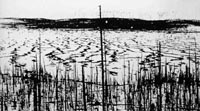Tunguska meteorite produced most powerful blast on Earth in 20th century
On 30 June 1908 at 7 o’clock in the morning a huge object fell through the sky. The object was so bright that the sun seemed dull in comparison. It fell to the earth and exploded with the power of a thousand Hiroshima bombs. The bomb fell near the Podkamennaya Tunguska River in Siberia. The shock wave completely destroyed the forest and huts 5-7 kilometres away. It felled trees that stood 25-30 kilometres from the explosion. A conductor stopped a train some 800 kilometres away thinking that one of the carriages had exploded. The bright fireball was even visible in Western Europe. The shock waves were spotted by almost every geographical observatory in use in 1908.

The powerful explosion and the emission of red hot gases from the burning forest caused devastation to the region. A few minutes after the explosion, a magnetic storm started which was registered in Irkutsk . It lasted more than four hours and was similar to the geomagnetic disturbances caused by a nuclear explosion. The area where these phenomena were observed is bound by the Yenisey River in the East, by the latitude of Tashkent-Stavropol-Sevastopol-Bordeaux in the South, and by the Atlantic coast in the West. The event has been written in history as “The White Nights of the summer of 1908.” On the night of 30 June it hardly became dark at all. This light was connected with the dawns which resemble the “volcanic twilight” which was observed after the eruption of Mount Krakatoa in 1883. At that time changes of the polarization of the twilight sky were observed. This phenomenon was noticed for 2-3 days before the explosion in Tunguska. The changes were observed in ten different places at night on 29th and 30th June. The biggest anomalies occurred on the night after the explosion and were recorded in 150 places in Europe and Asia . The intensity of the explosion in the regions furthest from the explosion quickly died down and the cosmic fireball had for the most part finished by 4 July. However, in several parts of Europe the echo could be heard until 20 July.
Within 19 years people had forgotten about the incident with the reasons for it were still unclear. When scientists came to explore the site, all they found was 2500 square metres of destroyed forest. Witnesses in neighbouring villages were found, who remembered the fireball flying through the night sky, the terrible noise and great clamour of the explosion. Explorers searched the area for evidence of a meteorite or asteroid, but did not even find a crater where the object may have landed.
Leonid Kulik was the first scientist to visit Tunguska. When he saw the enormous number of felled trees, he thought that there had been a fire. Kulik and his team examined the whole vicinity and took numerous photographs, but did not find anything. In the next fourteen years he made four further expeditions to Tunguska , but on each occasion he returned home with no evidence. Kulik died in captivity in 1942. After this, Russian scientists were sent to the site every summer. One of their most valuable achievements is the photographing of the whole 850 square metre site of the felled trees which took 35 years. The mapping of the site has allowed people to conclude that the explosion took place some 7 kilometres above the earth’s surface with the power of 20 megatonnes of TNT. Why a meteorite would explode at such a height is as yet unknown since no traces of the object have been found. Thus I have only found the incident referred to in English as “The Tunguska Explosion” and not as a “meteorite” since they are not sure that it was in fact a meteorite.
Evidence from the vicinity of the incident allows us to say that the trajectory of the object was from east to west. Witnesses say that the meteorite traveled from south to north. Investigations showed that the object fell at an angle of 40-45 degrees. Witnesses, however, were convinced that it traveled along a smoother plane. This suggests that the object changed its course whilst falling through the sky.
No traces of the Tunguska meteorite were found in the region of the catastrophe since it landed in a very small area. They say that the meteorite weighed approximately 100 000 tonnes before it exploded and that a large part of it during the explosion must have landed in the area under research and that with modern methods it will be possible to find them.
On the site of the centre of the explosion, trees have grown to a great height which is an indication of a release of radiation. Hiroshima and Tunguska also point to the consequences of radiation emissions. Young pine trees which have grown in the central area of the catastrophe have mutated to eleven times their normal size. This is the main theory given about UFO: it is supposed that the object flew over Earth, as a consequence of breaking on board a ship and decided to fall to the little-populated area before colliding with earth resulting in its destruction.
It was the most powerful explosion on Earth in the 20th century, but we still do not know how it occurred.
Translated by Michael Simpson
Subscribe to Pravda.Ru Telegram channel, Facebook, RSS!





